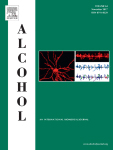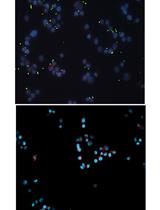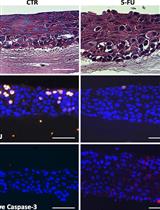- EN - English
- CN - 中文
Intracellular Invasion and Killing Assay to Investigate the Effects of Binge Alcohol Toxicity in Murine Alveolar Macrophages
研究酗酒酒精毒性对小鼠肺泡巨噬细胞影响的细胞内侵袭和杀伤试验
(*contributed equally to this work) 发布: 2019年01月20日第9卷第2期 DOI: 10.21769/BioProtoc.3143 浏览次数: 6420
评审: Emily CopeAnonymous reviewer(s)

相关实验方案

γ-H2AX作为标志物采用细胞内蛋白质印迹法(ICW)定量HeLa细胞中Colibactin相关基因毒性
Sophie Tronnet and Eric Oswald
2018年03月20日 7802 阅读
Abstract
Alcohol consumption has diverse and well-documented effects on the human immune system and its ability to defend against infective agents. While pulmonary related infections can occur in healthy humans, binge alcohol use is recognized as a major health risk factor (Nelson et al., 1991). Although binge alcohol consumption has been considered as a risk factor for the development of pulmonary infections, no experimental studies have investigated the outcomes of a single binge alcohol exposure during infection. A key assay to assess the effects of a single binge alcohol exposure on the interactions between bacteria and alveolar macrophage is a binge alcohol intracellular invasion and killing assay. MH-S alveolar macrophages (AMs) are exposed to a single binge alcohol dose prior to infection for 3 h. The macrophage monolayer is then infected to allow for engulfment, followed by removal of extracellular bacteria to assess the intracellular killing capacity of infected macrophages over time. We have utilized this assay to demonstrate that low alcohol exposure significantly suppressed the uptake and killing of less virulent Burkholderia thailandensis (B. thailandensis) by AMs. More recently we found that activated AMs with interferon (IFN)-γ incubated in alcohol (0.08%) for 3 h prior to infection showed significantly lower bacterial uptake at 2 and 8 h post infection, which lead to B. thailandensis survival and a ~2.5-fold replication increase compared to controls (Jimenez et al., 2017). These results provide insights into binge alcohol consumption, a culturally prevalent risk factor, as a predisposing factor for pulmonary bacterial infections. This assay can be adapted to other bacterial species and host cell types to assess tissue specific effects of alcohol during infection.
Keywords: Alcohol (酒精)Background
Alcohol is widely accepted as the most popular recreational drug with well-documented adverse effects associated across geographic and social boundaries (Jones and Holmgren, 2009; Pruett et al., 2010). Studies in both human and animal models indicate that acute alcohol or binge alcohol intake, which is characterized by consumption of alcohol reaching a blood alcohol concentration of at least 0.08% within 2-3 h, may be associated with increased health risks over the lifetime of the individual (Wechsler and Nelson, 2008; Moreira et al., 2009). We and others have demonstrated that excessive alcohol consumption is linked to impairment of macrophage function and increased risk for pulmonary infections and sepsis (Bhatty et al., 2011). Alveolar macrophages (AM) are the first line of defense during pulmonary infections, typically located in the distal respiratory tract (Knapp et al., 2003), and are capable of detecting, capturing, and eliminating invading pathogens while being responsible for initiating the early host immune response (Renwick et al., 2001; Qiu et al., 2012). Moreover, alcohol toxicity suppresses bacterial phagocytosis and killing in J774.16 macrophages when infected with Acinetobacter baumannii (Boé et al., 2001; Asplund et al., 2013). Additionally, chronic alcohol increases expression of virulence factors during infections and decreases pulmonary immune defenses in infections caused by Mycobacterium avium, Escherichia coli, Streptococcus pneumoniae, Klebsiella pneumoniae, and Staphylococcus aureus (Bermudez et al., 1993; Gordon et al., 2000; Goral et al., 2008; Camarena et al., 2010). The present assay was designed to investigate the effects of a single binge alcohol exposure on AM engulfment and intracellular killing of less virulent Gram-negative Burkholderia thailandensis. Our results indicate that a single binge alcohol episode can increase opportunistic bacterial infectivity while decreasing host innate immune responses to infection. Understanding the modulating capacity of very low alcohol exposure to alter the initial interaction between host immune mechanisms and pathogens during infection, provides important new insights into how risk factors such as alcohol can increase the infectivity of other non-virulent pathogens in otherwise healthy human hosts.
Materials and Reagents
- Pipette tips (USA scientific, catalog numbers: [10 μl] 1011212710; [200 μl] 11208710; [1,000 μl] 11267710)
- T-75 tissue culture flask (VWR, catalog number: 10062860)
- 5 ml serological transfer pipette (Corning, Falcon, catalog number: 357543)
- 10 ml serological transfer pipette (Corning, Falcon, catalog number: 356551)
- 25 ml serological transfer pipette (Corning, Falcon, catalog number: 356535)
- Tissue culture 24-well plates (Sigma-Aldrich, catalog number: SIAL0524)
- Sterile Petri dish (BD, Falcon, catalog number: 351029)
- 50 ml tube (Falcon, Becton Dickinson, catalog number:352098)
- 15 ml tube (Falcon, Becton Dickinson, catalog number: 352099)
- Eppendorf tubes (1.6 ml, Flat top) (Midwest Scientific, catalog number: SS1500)
- L-shaped spreader (USA Scientific, catalog number: 29775500)
- Burkholderia thailandensis E264
- 0.25% Trypsin (Gibco, Life Technologies, catalog number: 25200056)
- Phenol red-free RPMI-1640 medium (Life Technologies, Gibco, catalog number: 11835030)
- Heat Inactivated FBS (fetal bovine serum) (ATCC, catalog number: 80721500)
- 1 M HEPES (Sigma-Aldrich, catalog number: 7365459)
- 100x Non-Essential Amino Acid Solution (ATCC, catalog number: 302116)
- 75.0 g/L Sodium Bicarbonate Solution (HyClone, Thermo Scientific, catalog number: SH30033.01)
- 100x Antibiotic/Antimycotic Solution (J R Scientific, Inc., catalog number: 20004)
- 1x Ca2+/Mg2+-free DPBS (Gibco, Life Technologies, catalog number: A12856-01)
- Alveolar macrophages (AMs) (ATCC, catalog number: CRL-2019)
- 20 μg IFN-γ (ProSpec-Tany TechnoGene Ltd., catalog number: Cyt358a)
- Luria Bertani (LB) broth (BD, Difco, catalog number: 244620)
- Luria Bertani agar (BD, BBL, catalog number: 212304)
- Absolute Ethanol (200 proof) (Fisher Scientific, catalog number:174904)
- Kanamycin (BioChemika, Fluka, catalog number: 42904168)
- Clorox Germicidal Bleach (VWR, catalog number: 10028048)
- Triton X-100 (Sigma Chemical CO., catalog number:103H0421)
- 10% Heat inactivated FBS/1x DPBS (see Recipes)
- 1x antibiotic/antimycotic solution (see Recipes)
- Alveolar macrophage media (RPMI) (see Recipes)
- 200 U/μl IFN-γ (see Recipes)
- 0.08% ethanol (see Recipes)
- 250 or 50 μg/ml Kanamycin (see Recipes)
- 10% Clorox Bleach (see Recipes)
- 0.1% Triton X-100 (see Recipes)
Equipment
- P10 Pipetman (Rainin, catalog number: A0602538G)
- P20 Pipetman (VWR, catalog number: 041432480)
- P200 Pipetman (VWR, catalog number: 441454097)
- P1000 Pipetman (Gilson, catalog number: F123602)
- Spectrophotometer (Eppendorf, BioPhotometer, model number: 613124291)
- 37 °C, 5.5%, CO2 water jacketed Incubator (Eppendorf, New Brunswick, model number: C017051201000)
- Biosafety cabinet (Forma Scientific, model number: 1286)
- Shallow form water bath (Bio-Rad, Sheldon Manufacturing, INC., model number: BR122)
- Hemocytometer chamber (Hausser Scientific, catalog number: 3100)
- -20 °C freezer
- -80 °C freezer
- Inverted light microscope (VanGuard, model number: 002443)
- Autoclave
- Orbital floor shaker (New Brunswick Scientific CO., model number: C25)
- Refrigerated tabletop centrifuge for 2 ml tubes (Lab Care America, Jouan CR3, model number: CR3i)
- Centrifuge, Sorvall legend RT+ (Thermo Scientific, catalog number: 75004377)
Software
- GraphPad Prism 5 (GraphPad Software)
Procedure
文章信息
版权信息
© 2019 The Authors; exclusive licensee Bio-protocol LLC.
如何引用
Jimenez Jr, V. and Monroy, F. P. (2019). Intracellular Invasion and Killing Assay to Investigate the Effects of Binge Alcohol Toxicity in Murine Alveolar Macrophages. Bio-protocol 9(2): e3143. DOI: 10.21769/BioProtoc.3143.
分类
微生物学 > 微生物-宿主相互作用 > 体外实验模型 > 细胞系
免疫学 > 免疫细胞功能 > 巨噬细胞
细胞生物学 > 基于细胞的分析方法 > 集落形成
您对这篇实验方法有问题吗?
在此处发布您的问题,我们将邀请本文作者来回答。同时,我们会将您的问题发布到Bio-protocol Exchange,以便寻求社区成员的帮助。
提问指南
+ 问题描述
写下详细的问题描述,包括所有有助于他人回答您问题的信息(例如实验过程、条件和相关图像等)。
Share
Bluesky
X
Copy link










